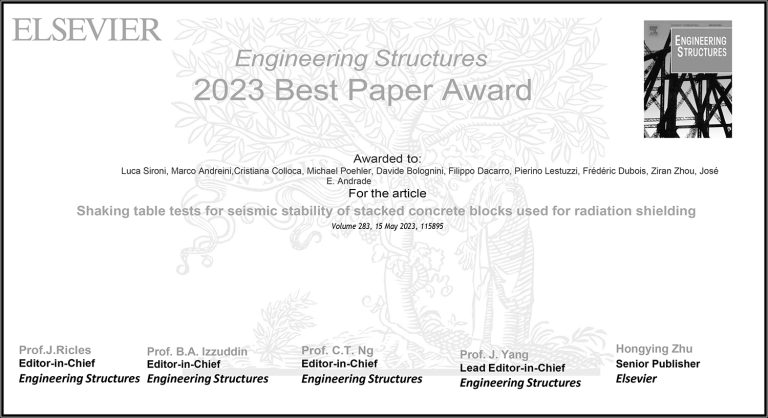Research on the seismic stability of precast concrete blocks for radiation shielding provides important information in the field.
At a time when seismic safety continues to be a challenge for engineers and researchers worldwide, a novel study funded by CERN of Geneva led by a group of researchers including Eucentre’s Engineers Davide Bolognini and Filippo Dacarro has won the prestigious Engineering Structures Best Article 2023 award. Their article, entitled “Shaking table tests for seismic stability of stacked concrete blocks used for radiation shielding“, is a testament to innovative research and commitment to improving the safety and resilience protective components with high functional flexibility.
The award-winning study, published in the May 2023 issue of Engineering Structures (Volume 283), is the result of a collaborative effort between CERN (European Organization for Nuclear Research), EPFL (Swiss Federal Institute of Technology), LMGC (Universitè de Montpellier), Caltech (California Institute of Technology) to investigate the seismic stability of stacked concrete blocks, a critical component in radiation shielding. This research leverages full-scale shaking table tests, with the experimental results contributing to an enhanced understanding of discrete system models used in seismic performance assessment.
Implications for the sector
The outcomes of the experimental test campaign formed the basis for a subsequent numerical investigation (https://ascelibrary.org/doi/10.1061/JENMDT.EMENG-7036), facilitating the further enhancement of calculation and stability verification methodologies for the shielding setups utilized at the CERN laboratories.
Recognition and future developments
The recognition by the journal Engineering Structures underlines the importance of research in the field of structural engineering. The Best Article Award reflects the excellence of the study and its contribution to the advancement of engineering practice and safety protocols.
Interacting with research
For those interested in exploring the winning study, it will be available for free to read, download from this LINK and share on Science Direct for the next six months. This initiative ensures that the valuable insights and methods presented in the article are widely available, encouraging further research and applications in the engineering community.

